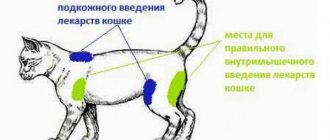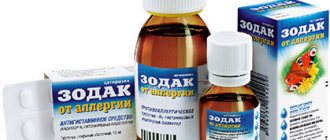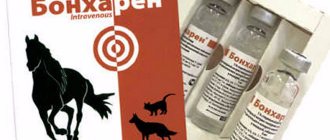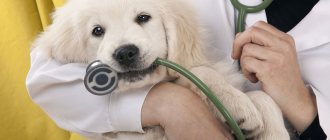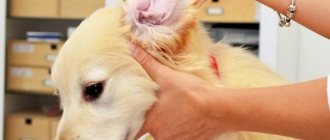Injections at home
In emergency situations, injections are given to the dog at home. There may be several reasons for home treatment.
Urgent need
Cases for emergency assistance: the animal has been seriously injured, is experiencing unbearable pain, the female has difficulty giving birth, or urgently needs to be injected with Oxytocin.
The owner is forced to administer an anesthetic, an antibiotic, a sedative, and a labor stimulant without waiting for the veterinarian to arrive.
No access to veterinary care
If the animal gets sick in a remote village, or weather conditions do not allow the dog to be taken to the clinic, the owner himself provides assistance to the animal.
Delay can cost the animal’s life; treatment cannot be delayed.
Animal in a stressful situation
A very frightened dog may not give itself into the hands of a stranger. Some animals experience stress from going to the veterinary clinic. If the situation does not require urgent medical attention, you can administer the medicine subcutaneously at home.
Desire to save money
A veterinarian's appointment, examination, and all subsequent manipulations are not cheap. In some cases, these expenses are not justified. Experienced dog breeders can easily handle subcutaneous injections without the assistance of a specialist.
Syringe selection
Injecting requires a certain skill and a properly selected instrument. The choice of syringe depends on the size of the dog.
Breed and age of the dog
For puppies or small breed dogs, it is recommended to administer medications with an insulin syringe . It has the shortest and thinnest needle. It is not completely injected under the skin.
For large breeds, the syringe is selected according to the volume of medication administered. If it is necessary to inject 1 ml of a substance, use a 2 ml syringe. The needle is carefully inserted under the skin, deepening it by more than 1/3 of its length.
Type of drug
Subcutaneous medications are administered after consultation with a veterinarian. The appropriate drug must be used.
Substances for intravenous administration cause allergies or tissue death when they are introduced under the skin.
Medicines with an oily structure
Dense liquids are injected with a syringe with a thick needle. The drug will not leak through a thin one, like on insulin syringes, it will clog the hole.
Volume of injected fluid
If the dosage of the drug reaches 5 ml, you cannot take a 2 ml syringe and inject the substance several times.
The animal will not tolerate such execution. Select a syringe of the appropriate size. The needle from such an instrument can be thick; it is inserted very carefully, only the tip is pushed under the skin.
Preparing for the injection
To complete the medicine kit you will need:
- alcohol wipes or cotton wool soaked in alcohol;
- cotton ball;
- medicine, solvent for it;
- syringe, preferably with two needles.
Types of syringes
For dogs weighing up to 5 kg, insulin syringes are used if there is no need to inject viscous oily solutions that such a needle cannot pass through, or the dosage of the medicine does not exceed 1 ml. In other cases, preference is given to an instrument with a capacity of 2–3 ml. For representatives of large breeds, syringes of 5–10 ml are used, but they try to use a thinner needle (as much as the drug allows).
Before the injection, wash your hands thoroughly and treat them with an antiseptic, for example, chlorhexidine. Do not touch the needle.
Antiseptics for hand treatment
Carefully study the instructions for the drug and prepare solvents. Cold liquids are heated by immersing the bottle in warm water (about 40 ° C) or left for some time at room temperature. This will reduce pain in the animal and prevent complications. They also study the date of manufacture of the drug to ensure its suitability, check the integrity of the packaging and compliance with the concentration prescribed by the veterinarian.
Before use, carefully study the instructions for the drug
Attention! Ready-to-use solutions should not contain sediment, and the color should correspond to that described in the instructions. Otherwise, use of the drug is prohibited.
Next, check the syringe. Cracks in the body or damage to the needle are unacceptable. If an expiration date is indicated, then after its expiration the product is not used. The type and capacity of the syringe should correspond to the medicine and its dosage, but be slightly larger.
If necessary, mix the drug by rolling the bottle between the palms of your hands. There is no need to shake the container to prevent air from getting into the liquid.
Then proceed in this order:
- Remove the metal cap from the bottle.
- Wipe the lid with an alcohol wipe.
- Use a needle to pierce the lid or cut off the glass top with a blade.
- Connect the syringe.
- Take the required dose.
Many medications come in powder form and must be diluted before use. Then first draw the solvent into the syringe, then inject it into the ampoule with the powder and stir until the product is completely dissolved.
All air must be removed from the syringe
Next, you need to check whether air has gotten inside. To do this, lightly tap the syringe with your fingernail. If air was in the liquid, it rises to the surface. Then press down on the plunger until several continuous drops of liquid emerge from the needle.
Video - How to dilute drugs
Algorithm
Most drugs for animals are injected into the withers. This is the simplest manipulation that every owner should learn to do.
Procedure:
Wash the hands.- Turn the ampoule upside down and shake.
- Break it at its thinnest point.
- Use a syringe to draw out the required amount of medicine.
- Release the air from the syringe by pressing the plunger until a drop of liquid appears at the tip of the needle.
- Using two fingers, pull back the skin on the dog’s withers and remove the hair.
- Insert the needle under the skin at an angle of 45 ᵒ, carefully, slowly and without deepening it beyond the tip.
- Inject the medicine under the skin.
- Quickly remove the needle, holding the skin fold.
There is no need to disinfect the injection site before and after: dogs have a special protective layer on their skin. It is prohibited to touch the needle with your hands before administering the medicine.
How to do it
How to give a dog a subcutaneous injection:
Draw the required drug into the syringe. In this case, the drug should be at room temperature, so if the ampoules according to the instructions should be stored in the refrigerator, then before administration, leave them for half an hour outside the refrigerator or hold them in your fist for 5-10 minutes so that the solution is not cold and does not bring additional discomfort during injection. After drawing the substance into the syringe, release all air and bubbles, as required for human injections.
- Lure your pet with a confident voice; your patient should not suspect you of fear or uncertainty. You can call the dog for a treat, and then carefully capture the satisfied animal. It’s good if you perform the entire procedure with an assistant so that the dog does not jerk at the wrong moment.
- Dogs do not need to wet or wipe the injection site with alcohol or antiseptic. A sterile needle, a correctly drawn drug and easy administration are enough, because the skin of dogs has a protective layer that promotes rapid healing of a small puncture, but the sterilization process violates this natural barrier.
- Feel the reserve of skin at the withers and lift the fold, tilt it at an angle of 45' and insert the needle. Do not insert the needle deeply, if you are using an insulin syringe, then the needle should go halfway, if you are using a regular needle, then a subcutaneous injection requires inserting 1/3 of the needle. The only exceptions are breeds with very thick skin; for such dogs, a regular needle needs to be deepened halfway. If you are in doubt, it is better to consult your veterinarian about the depth of insertion of different types of needles for your particular dog.
- After you have smoothly introduced the drug, taken out the needle, gently pat the dog’s withers so that the drug spreads a little and begins to be absorbed by the tissues. To the touch after a minute, the injection site should give a slight sensation of a small bump from the injected drug, and blood should not ooze from the puncture site.
- You can let your dog go, rewarding his patience with another portion of treats.
IMPORTANT: you, of course, can vaccinate your dog yourself, but keep in mind that only a certified specialist can put a mark on the veterinary passport recognizing the vaccination as valid.
To avoid complications, namely a bump on the dog’s withers after injections, do everything quickly, but not unexpectedly for the pet. Secure the dog so that it does not twitch when the drug is administered.
If your dog has significant fat on the scruff of the neck, then it is better to entrust the administration of the drug to a veterinarian. Also, make sure your hands are clean during the procedure - it is not recommended to disinfect the injection site, but the syringe itself, the needle and your hands must be sterile.
IMPORTANT: do not inject several drugs into the same place and with the same needle, simply changing the syringe itself with filling. Mixing drugs, either during collection or already under the dog’s skin, can give a completely unpredictable reaction.
Animal location
It is important to position and secure your pet correctly in order to accurately administer the injection. This ensures that the animal will not jerk or run away at the most crucial moment.
Large animal
Shepherd, Great Dane, St. Bernard can sit on the floor. The dog should sit or lie stretched out on its legs. It is good to ask another family member to calm the animal down and restrain it so that it does not jerk or bite the person.
Small pet
It is convenient for a small dog to get an injection at an elevated location.
The pet is placed on a table or any other hard and flat surface level with the owner’s belt, the animal is calmed down, and one person fixes it. If the dog breaks out or bites, it is held by the head and body. At this time, the animal owner introduces the contents of the ampoule.
Preparations for the procedure
Before injecting a dog intramuscularly, a syringe filled with a solution is prepared in advance. It is advisable to avoid the presence of a four-legged patient when preparing for manipulation. The sight of tools and unknown smells can frighten the animal. Tension and anxiety of the patient will complicate the procedure.
A muscle that is compressed during a moment of stress is more difficult to pierce with a needle. Painful sensations in a frightened state will be stronger. The pet will forever remember the acute discomfort and will hide as soon as it sees the syringe.
It is also worth considering that a tense muscle and narrowed blood vessels are serious obstacles to the normal absorption of the medicinal solution. Side effects - inflammation, lameness - will not keep you waiting.
Alternating limbs will help minimize pain during the course of injection therapy.
The most suitable moment for the procedure is before going to bed, after a walk and lunch. However, please note: some medications are administered after sleep or before meals (read the instructions and listen to your veterinarian's recommendations). Immediately before sensitive manipulation, devote a few minutes to psychological relaxation of your pet: gently pat behind the ear, say a few kind words.
If this is your first time giving an intramuscular injection and you don’t know how your dog will behave, enlist the support of your loved ones. The assistant should sit at the patient's head and be ready to restrain the obstinate person as he tries to escape. There is no need to force the animal to lie down or forcefully press it to the floor - this will provoke a panic attack in the poor fellow, which will not benefit the matter.
Sudden pain can cause a nervous or dominant dog to bite its owner. A muzzle will help prevent spontaneous aggression from your pet.
Preparation of the drug
Before the procedure, the medicine is taken out of the refrigerator, brought to room temperature, the ampoule is opened, and drawn into a syringe.
Bottle
Puncture the rubber lid of the container with a needle, immerse the tip inside, and draw out the required amount of the drug. The remains are hermetically sealed and sent to the refrigerator for storage. If the drug is not intended for further use, it is disposed of.
Ampoule
The container is cut with a special file, which is inserted into each package. Then the ampoule is broken at the thinnest point.
Types of injections
In addition to injections into the withers, dogs are given intravenous and intramuscular injections. Procedures are difficult to perform without training. Some of them are carried out only in a clinical setting.
Intravenous
Such injections are not given at home. Only a veterinarian can do them. Usually a special catheter is inserted into a dog’s vein, through which the drug is injected.
This is convenient, since the puncture is done only once.
Intramuscular
The owner can carry out the manipulation at home. It does not require special skills.
Action plan:
- Secure the animal.
- Fill the syringe with medicine.
- Squeeze all the air out of it.
- Inject the drug into the largest muscle on the hind leg.
During the procedure, the dog should lie down and not stand.
Subcutaneous
The drug is injected into the withers of the animal. This is a less traumatic and painful procedure for the animal.
Subcutaneous injections
If the annotation for the medicine or the veterinarian's recommendations indicate that the dog should be given a subcutaneous injection, then the needle is inserted under the skin (without penetrating the muscle) on the withers, shoulder or inner thigh. When choosing the injection site, it should be taken into account that the withers are the least sensitive, but very dense and thick. The inner surface of the thighs, on the contrary, is very soft, but is penetrated by a large number of vessels that can be easily pierced with a needle. Therefore, if you have no experience, it is better to give a subcutaneous injection to the dog in the withers or shoulder. If the course of treatment is long, and the drug causes severe pain when administered, it is recommended to inject alternately - at the withers, one and the other shoulder.
How to give an injection to a dog at the withers
The withers are the place between the shoulder blades, which is designed by nature to protect the dog during fights with other animals. That is why the skin here is rough and not very sensitive. This imposes certain requirements on the injection - in order not to bend the needle, it is injected more slowly than usual.
Before injecting your dog at the withers, it is important to correctly determine the injection site. Since this area borders the neck, you cannot pierce the skin too high, otherwise it will be injured by the collar, which is dangerous due to irritation, infection and the development of an inflammatory process.
The procedure is carried out according to the following scheme:
- the skin is pressed into a fold and the top is pulled back;
- the needle is inserted at the bottom of the fold, just above the place where the skin has moved away from the body, at an angle of 45º;
- the depth of penetration of the needle is controlled so that it just enters the subcutaneous space (this will be indicated by the cessation of skin resistance);
- After this, the medicine is released by pressing on the piston.
It is necessary to carefully focus on the process so as not to pierce the second side of the fold and not release the drug out. The advantage is that there are no nerves or important blood vessels on the withers, so it is impossible to harm the dog.
Technique of injections in other places
Since the method of subcutaneous administration of the drug is always the same and does not depend on the injection site, it must be performed according to the same scheme as an injection into the dog’s withers. The only differences may lie in the method of puncturing the skin - the denser it is, the slower the needle must be inserted. The injection speed of the medicine itself does not matter during subcutaneous injection.
Other places to administer the drug under the skin are:
- knee fold;
- inner thigh.
In rare cases, according to individual indications, a dog is given an injection under the shoulder blade.
Theoretically, a subcutaneous injection can be given throughout the animal's entire body. But if we take into account a number of physiological characteristics and the danger of developing complications, then it is better to stab only at the withers and shoulder.
Important! Dogs are very sensitive to their owner's insecurity and nervousness. Therefore, when giving an injection, precision and speed in performing all manipulations is necessary.
Adverse reactions
Even a simple medical procedure can cause complications. It is important for the dog owner to know what to do if the situation gets out of control.
Nerve hit
This can happen if the intramuscular injection is given incorrectly. After the injection, the dog may drag its paw. To avoid troubles, rub the injection site and massage the limb.
If the pain in the paw does not go away for a long time and the dog limps, it means that a bundle of nerves is affected. In this case, they contact the veterinarian and do a novocaine blockade.
There was blood in the syringe
Such a nuisance can occur with subcutaneous and intramuscular administration of the drug.
This means that a vessel or capillary is affected. This situation does not pose any danger to the dog. The needle is removed from the animal's body and inserted into another area. The blood should be blotted with a cotton swab soaked in antiseptic.
A hematoma has formed
If the needle does not enter the muscle correctly, or a large amount of medication is injected quickly, a hematoma will form. This is a slight swelling in the puncture area. Usually it goes away on its own. To speed up the process, this area is periodically rubbed and massaged.
If the lump increases in size, breaks out, or becomes painful, you should contact a veterinary clinic.
Intramuscular injection in the thigh
Injecting the drug into the muscle allows you to quickly deliver the medicine to the diseased organ and avoid irritation of the walls of the digestive system. Therefore, such procedures are prescribed when long-term course treatment of serious animal diseases is necessary.
Step-by-step instructions allow you to correctly and quickly inject the medicine into a dog’s muscle.
Selecting a syringe
The insulin syringe is suitable for injections in puppies and miniature breed dogs. Its thin needle easily and almost imperceptibly enters the muscle tissue.
Injection with an insulin syringe is prohibited when injecting a solution with sediment or oily consistency. Such liquid can clog the narrow hole of the needle.
The 2 ml syringe is equipped with a thin needle that can reach the muscle layer of a medium-sized dog. Therefore, when prescribing 3-5 ml of medication, you can transfer it to a larger volume instrument.
A 5-ml syringe is used to administer the medicinal solution to large and giant breed dogs. Its long needle reaches the deep muscle layers and distributes the drug evenly.
We collect medicine
Examine the ampoule. The name and expiration date of the drug should be clearly visible on it. Shake the container if a sediment has formed or heat it in the palm of your hand if it has been stored in the refrigerator.
Wash your hands, prepare alcohol and sponges for disinfection. Run a special nail file over the ampoule, and then open it with a movement away from you. Inject the liquid into the syringe through the hole in the needle.
Make sure the dosage is measured correctly. To do this, it is better to use syringes with a clearly marked scale. Lift the tool with the needle up and release all the air from it.
Determining the injection site
The best sites for intramuscular injection are the thighs. There are no large blood vessels or nerve endings in this part of the body, and the bone is far from the skin.
Knowing that you need to inject your dog in the hip area, feel this area while brushing the fur. While the dog is relaxed, evaluate the condition of the skin, the thickness of the muscle, and the distance to the bone.
Dosage and rate of administration
The veterinarian determines the dosage of the medicine, taking into account the severity of the dog’s condition and its weight, namely:
- up to 2 kg – 1 ml;
- 2-10 kg – 2-3 ml;
- 10-30 kg – 3-4 ml;
- heavier than 30 kg – 5-6 ml.
The larger the volume of the medicine, the slower it needs to be injected into the muscle. So, each milliliter of solution should enter the tissue in 2-3 seconds.
How to avoid complications
The consequences of improper administration of drugs require long-term treatment. Simple recommendations will help you avoid this.
Basic Rules:
The medicine is administered with a sterile syringe.- Manipulation is carried out only with clean hands.
- The syringe must be appropriate for the weight and age of the dog.
- Do not mix several medications in one syringe.
- The needle is not completely inserted into the skin or muscle.
We must not forget that the dog senses the owner’s uncertainty, so all actions are carried out quickly and clearly.

